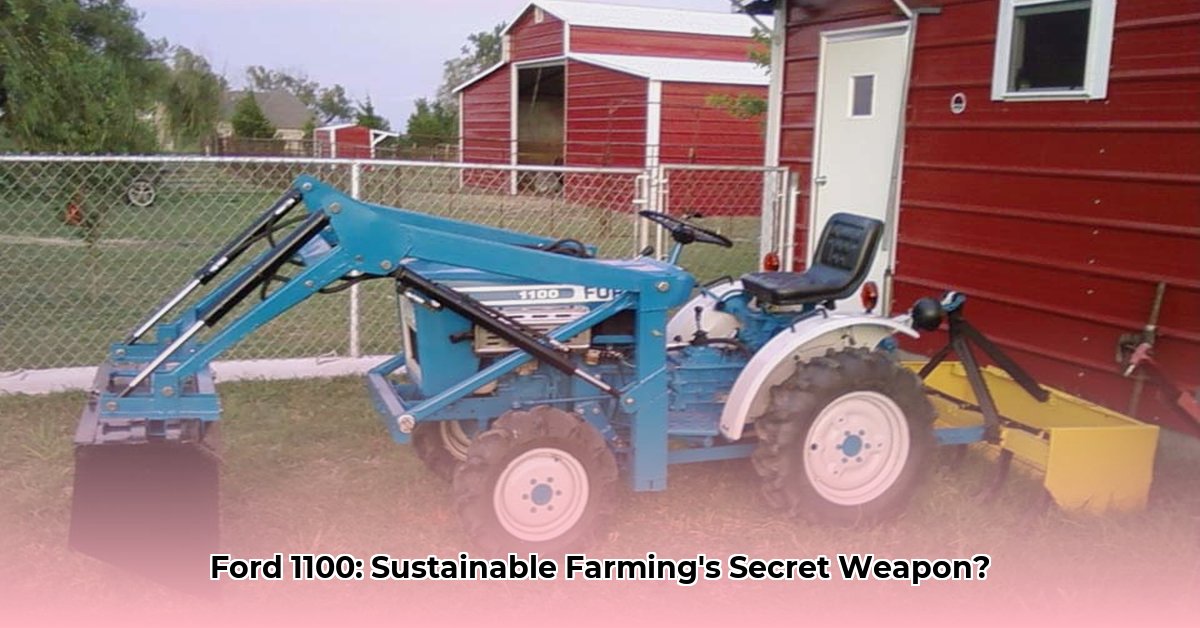
The Ford 1100 tractor, a stalwart of farms in the late 1970s and early 1980s, presents a compelling case study in sustainable agriculture. While its modest horsepower pales in comparison to modern behemoths, a closer examination of its specifications reveals surprising relevance for today's environmentally conscious farmers. For more on similar models, check out information on the Ford 850. This article analyzes its strengths and weaknesses, highlighting its potential role within a broader framework of sustainable farming practices.
Power and Efficiency: A Balancing Act
The Ford 1100, boasting a 12.5 horsepower engine (equivalent to approximately 9.3 kilowatts) and a 3.7-gallon fuel tank, was undeniably less powerful than its contemporary counterparts. While this smaller engine likely resulted in lower fuel consumption per hour compared to larger models, the reduced power output might have increased the time – and consequently, the fuel – needed for specific tasks. This highlights a persistent trade-off in agricultural machinery: efficiency versus power. Was this balance sustainable? The answer depends on a multifaceted analysis.
Repairability and Longevity: A Simple Design's Advantage
Unlike modern tractors brimming with complex electronics, the Ford 1100’s relatively simple mechanical design contributes to its potential for longevity. Its straightforward mechanics facilitate easier repairs and maintenance, potentially extending its lifespan significantly and reducing the need for frequent replacements. However, sourcing parts for a vintage machine like the 1100 presents a significant challenge. This inherent difficulty in parts acquisition could ultimately limit the tractor's actual lifespan, despite its inherent durability.
Soil Impact and Sustainable Practices: The Need for Further Data
The Ford 1100's compact size suggests reduced soil compaction compared to heavier, more powerful tractors. This is crucial for maintaining soil health, a cornerstone of sustainable agriculture. However, the actual ground pressure exerted depends on several critical factors, including tire pressure and overall weight distribution, which requires further research and data analysis. Without these specifics, a conclusive assessment of its impact on soil health remains elusive.
Life Cycle Assessment (LCA): A Holistic Perspective
A comprehensive evaluation of the Ford 1100’s environmental impact necessitates a life cycle assessment (LCA), considering its entire lifespan – from manufacturing and operation to eventual disposal. While its lower fuel consumption during operation points towards environmental friendliness, the manufacturing process and the environmental cost of disposing of the tractor at the end of its life must be factored into the equation. Only through a complete LCA can we determine whether the operational benefits outweigh the environmental burden of its creation and disposal.
Addressing Data Gaps: Research and Collaboration
A significant obstacle in evaluating the Ford 1100’s sustainability is the limited availability of comprehensive data. Detailed information on long-term operating costs, precise fuel consumption rates (liters per hour, for instance), and maintenance records remains scarce. To overcome these challenges, collaboration is needed, bringing together diverse stakeholders:
- Antique Tractor Owners: Documenting maintenance practices and sharing experiences is essential to building a comprehensive understanding of the tractor’s lifespan and maintenance needs.
- Agricultural Historians: Analyzing the Ford 1100's role in the evolution of farming technology can provide valuable context for its sustainability.
- Researchers/Academia: Conducting LCAs comparing the Ford 1100 to tractors from the same era is imperative. This would provide a clearer picture of its relative environmental impact.
- Policy Makers: Incentivizing the refurbishment and responsible recycling of older farm equipment is needed to encourage sustainable practices.
Conclusion: Bridging the Past and Future of Sustainable Farming
The Ford 1100’s sustainability story remains incomplete. While its design and potentially lower fuel consumption offer environmental advantages, crucial data gaps and the challenge of parts acquisition hinder a definitive assessment. Further research and collaboration are paramount to fully understanding its place within the broader context of sustainable agriculture and informing the design of future, more environmentally friendly farm machinery. The Ford 1100 serves as a valuable reminder that sustainable farming requires a holistic approach, considering the entire life cycle of equipment along with practical considerations such as parts availability.